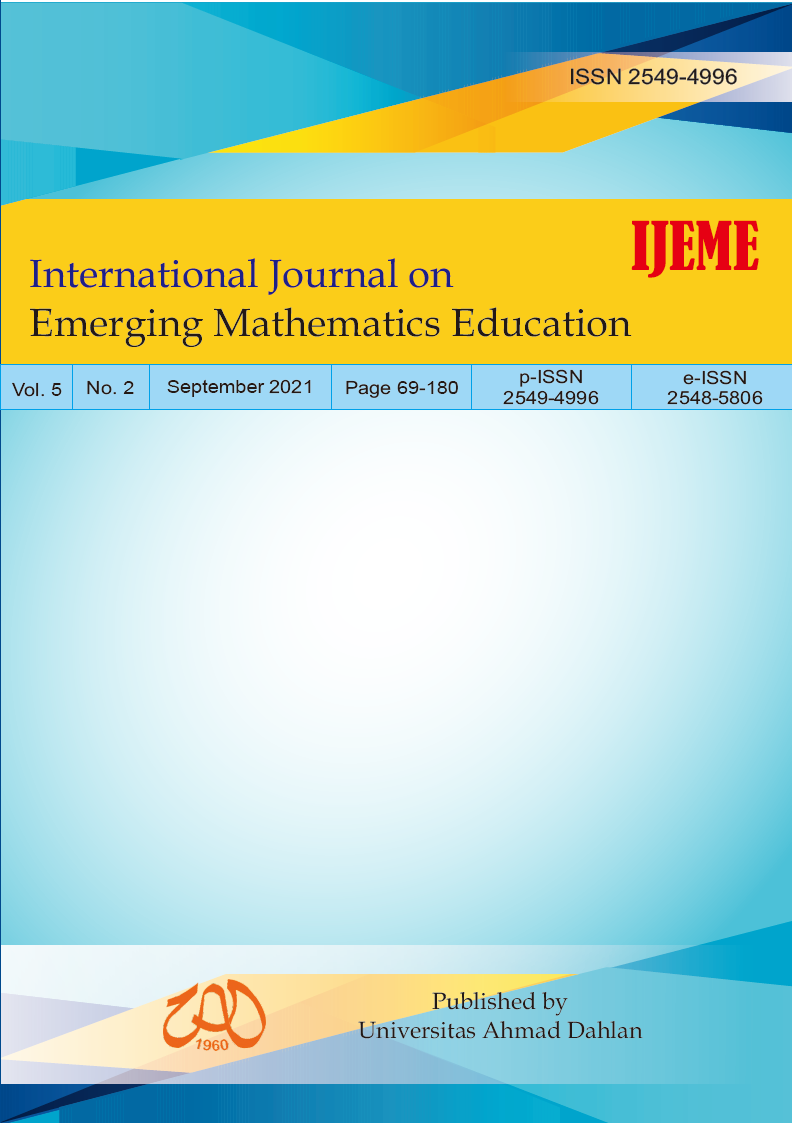Developing Number Theory Textbook for Pre-Service Mathematics Teacher of International Program
DOI:
https://doi.org/10.12928/ijeme.v5i2.19779Keywords:
design research, international program of mathematics education, number theory course, pre-service mathematics teacherAbstract
The long-term objective of this research is to produce valid, practical, and effective textbooks for courses in international program of mathematics education of Universitas Ahmad Dahlan. For the short-term, this research aims to produce valid and practical textbook for number theory course. The validity was based on the relevancy towards the students’ expected competence, while the practicality was measured from the implementation of learning using the textbook. This research used design research with the type of development studies. It followed four steps, i.e. (1) preliminary research, (2) prototyping stage, (3) summative evaluation, and (4) systemic reflection and documentation. In the preliminary research, we analyzed the need of the textbook in the international program and found that the textbook of number theory course is very needed. In the prototyping stage, we wrote the textbook based on the need analysis. The prototype was then discussed with expert and revised in the stage of summative evaluation and applied to the lecture meetings. The result was the final product of the textbook used for the stage of systemic reflection and documentation when we wrote all the results according to the preset research framework. Finally, the developed number theory textbook is valid and practical.References
Adenegan, K. E. (2010). Setting Mathematics Laboratory at Schools. B.Sc. (Ed.) Project. Ondo: Adeyemi College of Education.
Amir, A. (2013). Pengembangan Profesionalisme Guru dalam Pembelajaran melalui Model Lesson Study. Logaritma, 1(2).
Artini, L. P. (2013). Penggunaan English as Medium of Instruction (EMI) dan Konsekuensinya terhadap Proses Pembelajaran Ditinjau dari Persepsi Siswa. Jurnal Ilmu Sosial dan Humaniora, 2(1), 166-178.
Gatehouse, K. (2001). Key Issues in English for Specific Purposes (ESP) Curriculum Development. The Internet TESL Journal, 7(10), Available at: http://iteslj.org/Articles/Gatehouse-ESP.html/.
Jalal, F. (2007). Sertifikasi Guru untuk Mewujudkan Pendidikan yang Bermutu. Medan: Universitas Negeri Medan.
Javid, C. Z. (2013). English for Spesific Purposes: Its Definition, Characteristics, Scope, and Purposes. European Journal of Scientific Research, 112(1), 138-151.
Kopertis Wilayah V. (2015). Kopertis Wilayah V dalam Angka Tahun 2015. Available at: http://kopertis5.org/buku-statistik/.
Kunandar. (2007). Guru Profesional Implementasi Kurikulum Tingkat Satuan Pendidikan (KTSP) dan Sukses dalam Sertifikasi Guru. Jakarta: Rajagrafindo Persada.
Mulyasa, H. E. (2009). Implementasi Kurikulum Tingkat Satuan Pendidikan Kemandirian Guru dan Kepala Sekolah. Jakarta: Bumi Aksara.
Okigbo, E. C., & Osuafor, A. M. (2008). Effect of using mathematics laboratory in teaching mathematics on the achievement of mathematics students. Journal of Educational Research and Review, 3(8), 257-261.
Prodi Pendidikan Matematika UAD. (2013). Program Unggulan. Available at:
http://pmat.uad.ac.id/pendidikan-matematika-kelas-internasional/.
Prahmana, R. C. I. (2017). Design Research (Teori dan Implementasinya: Suatu Pengantar). Jakarta: Rajawali Pers.
van den Akker, J., Gravemeijer, K., McKenney, S., & Nieveen, N. (Eds.). (2006). Educational design research. Routledge.
Downloads
Published
How to Cite
Issue
Section
License
License and Copyright Agreement
In submitting the manuscript to the journal, the authors certify that:
- They are authorized by their co-authors to enter into these arrangements.
- The work described has not been formally published before, except in the form of an abstract or as part of a published lecture, review, thesis, or overlay journal. Please also carefully read the International Journal on Emerging Mathematics Education (IJEME) Author Guidelines at http://journal.uad.ac.id/index.php/IJEME/about/submissions#authorGuidelines
- That it is not under consideration for publication elsewhere,
- That its publication has been approved by all the author(s) and by the responsible authorities, tacitly or explicitly, of the institutes where the work has been carried out.
- They secure the right to reproduce any material that has already been published or copyrighted elsewhere.
- They agree to the following license and copyright agreement.
Copyright
Authors who publish with the International Journal on Emerging Mathematics Education (IJEME) agree to the following terms:
- Authors retain copyright and grant the journal the right of first publication with the work simultaneously licensed under a Creative Commons Attribution License (CC BY-SA 4.0) that allows others to share the work with an acknowledgment of the work's authorship and initial publication in this journal.
- Authors are able to enter into separate, additional contractual arrangements for the non-exclusive distribution of the journal's published version of the work (e.g., post it to an institutional repository or publish it in a book), with an acknowledgment of its initial publication in this journal.
- Authors are permitted and encouraged to post their work online (e.g., in institutional repositories or on their website) prior to and during the submission process, as it can lead to productive exchanges, as well as earlier and greater citation of published work.
![]()
Ciptaan disebarluaskan di bawah Lisensi Creative Commons Atribusi-BerbagiSerupa 4.0 Internasional.





